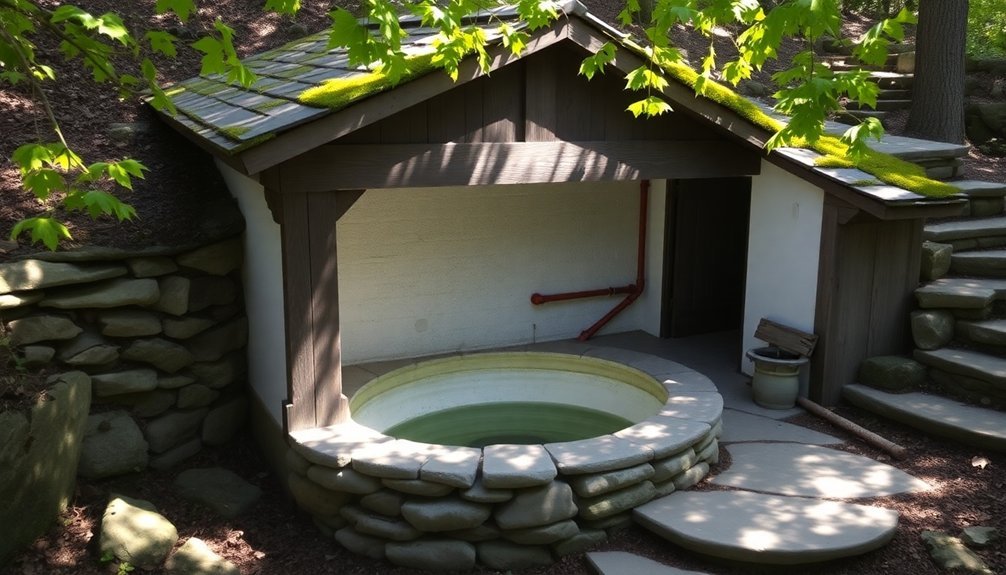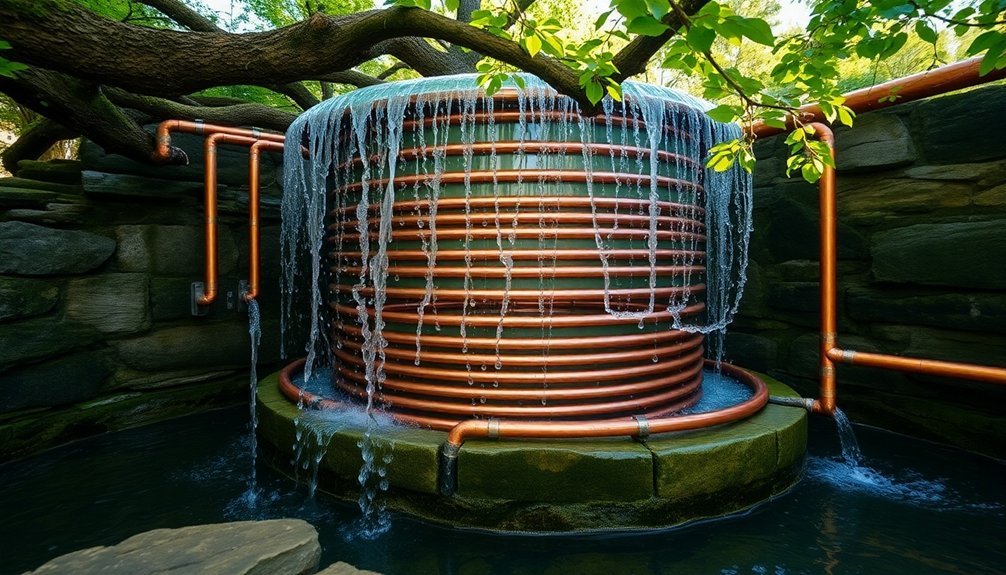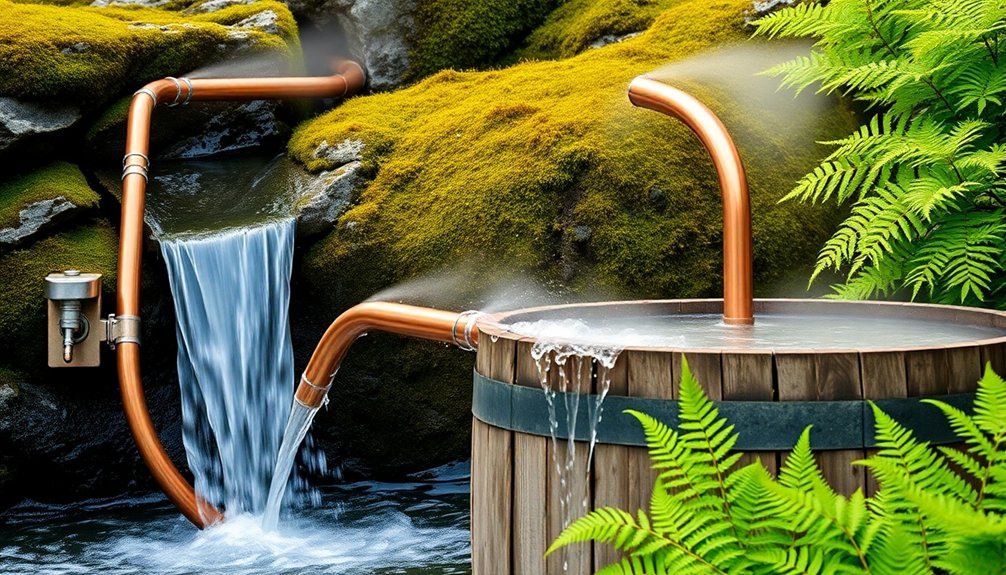You can harness cold spring water in three highly effective ways to maximize its natural benefits. First, construct a spring house with reinforced concrete and proper insulation to create a temperature-controlled storage space for food preservation. Second, install an underground collection system using specialized tanks that can store thousands of gallons while maintaining consistent cool temperatures. Third, implement a natural cooling mechanism that uses the spring water's thermal properties for energy-efficient climate control in buildings. These sustainable solutions offer just a glimpse of how you can tap into nature's own cooling power.
Spring House Construction Basics

Throughout the construction of a spring house, proper planning and attention to detail guarantee a functional and lasting structure. You'll need to start by selecting an elevated location near the spring that prevents flooding while ensuring the ground remains level and hazard-free. Local regulations must be reviewed and followed before beginning construction.
Consider the natural slope to promote proper water runoff and maintain easy access for future maintenance.
Before breaking ground, create a detailed construction plan that includes your spring house's dimensions, material requirements, and essential features like shelving and cooling systems.
You'll want to excavate the area roughly 4 feet deep, ensuring enough space for your planned structure. Pour a reinforced concrete floor using rebar to prevent cracking, and construct durable walls using concrete blocks or stone.
Install a weather-resistant roof using metal or asphalt shingles to protect your structure from the elements.
Don't forget to build a retaining wall around the spring to keep debris out, and install necessary piping from the spring to your trough or refrigeration area.
You'll also need to add practical elements like steps, shelves, and a sturdy door to complete your spring house.
Underground Water Collection System
Designed for maximum efficiency and space conservation, underground water collection systems offer a sophisticated approach to water storage and management. You'll find these systems particularly valuable as they're concealed beneath the ground, protecting your water supply from freezing temperatures while creating an ideal environment that reduces algae and microbial growth.
These systems are engineered to handle various types of water including wastewater and stormwater.
You can choose from several tank options that'll suit your specific needs:
- Fiberglass tanks that provide superior structural strength and corrosion resistance
- Polyethylene tanks manufactured from FDA-approved materials for both potable and non-potable water
- Custom-sized tanks ranging from 1,500 to 122,000 liters to match your capacity requirements
When you're planning your installation, you'll need to take into account vital factors like elevation differences between gutters and tank inlets, proper water-tight connections, and effective collection pipe placement.
Your system's ribbed design will support the surrounding soil while underground, and you'll want to ascertain proper surface water diversion to prevent contamination.
Natural Cooling Storage Design

Building upon the benefits of underground storage, natural cooling storage systems harness cold spring water's thermal properties for year-round temperature control. Similar to how root cellar temperatures remain stable between 30-50°F, you'll find that water's exceptional heat storage capacity of 995 BTUs per gallon makes it an ideal medium for temperature regulation in your home or facility.
| Design Element | Benefit |
|---|---|
| Water Storage Tanks | Store up to 33,000 gallons for winter heating needs |
| Insulation Materials | Prevent heat loss and maintain consistent temperatures |
| Evaporative Chambers | Cool produce through water evaporation in dry climates |
| Natural Ventilation | Reduce mechanical cooling requirements |
You can maximize efficiency by incorporating multiple 1500-liter PE tanks, which offer better temperature control than single large units. When you combine these water storage systems with natural ventilation strategies and thermal mass principles, you'll create a robust cooling solution that works even during power outages. For enhanced performance, consider integrating phase-change materials alongside your spring water system – they'll provide additional thermal storage capacity while helping shift peak energy loads to off-peak hours. This combination can lead to substantial energy savings, potentially reaching millions in cost reductions across multiple installations.
Frequently Asked Questions
How Can I Legally Protect My Spring Water Source From Neighboring Property Development?
You can acquire surrounding land, establish a Critical Environmental Area, update local zoning laws, and work with authorities to designate protection zones. You'll also want to document water rights through proper legal channels.
What Are the Seasonal Variations in Spring Water Temperature and Flow Rates?
You'll notice your spring water stays cooler in summer (9.7°F below stream temps) and warmer in winter (7.0°F above stream temps). Flow rates typically decrease in summer due to less rainfall and higher evaporation.
Can Spring Water Collection Systems Be Integrated With Existing Well Systems?
Yes, you can integrate spring water with your well system if they share a common aquifer. You'll need to guarantee proper water quality testing, compatible pressure levels, and install measures to prevent cross-contamination between systems.
What Wildlife Impacts Should Be Considered When Developing a Spring Water Source?
You'll need to assess habitat disruption for endemic species, maintain minimum water flow rates, protect water purity, and avoid disturbing temperature-sensitive creatures. Consider fencing to manage wildlife access while ensuring their survival.
How Do Different Soil Types Affect Spring Water Mineral Content and Taste?
You'll notice clay and silt soils produce more mineralized water with stronger taste due to their high surface area, while sandy soils yield lighter-tasting water since they don't hold minerals as effectively.
In Summary
You'll find any of these three spring water systems can provide reliable access to clean, cold water while reducing your energy costs. Whether you choose to build a traditional spring house, install an underground collection system, or create a natural cooling storage space, you're making a sustainable choice. Start with the method that best fits your property and needs, then expand your water management system over time.





Leave a Reply